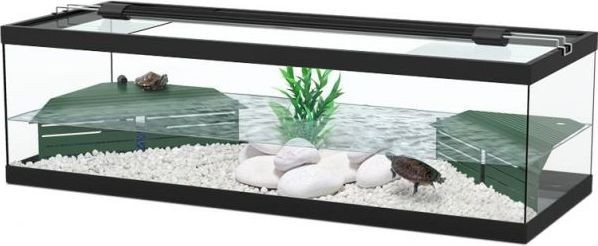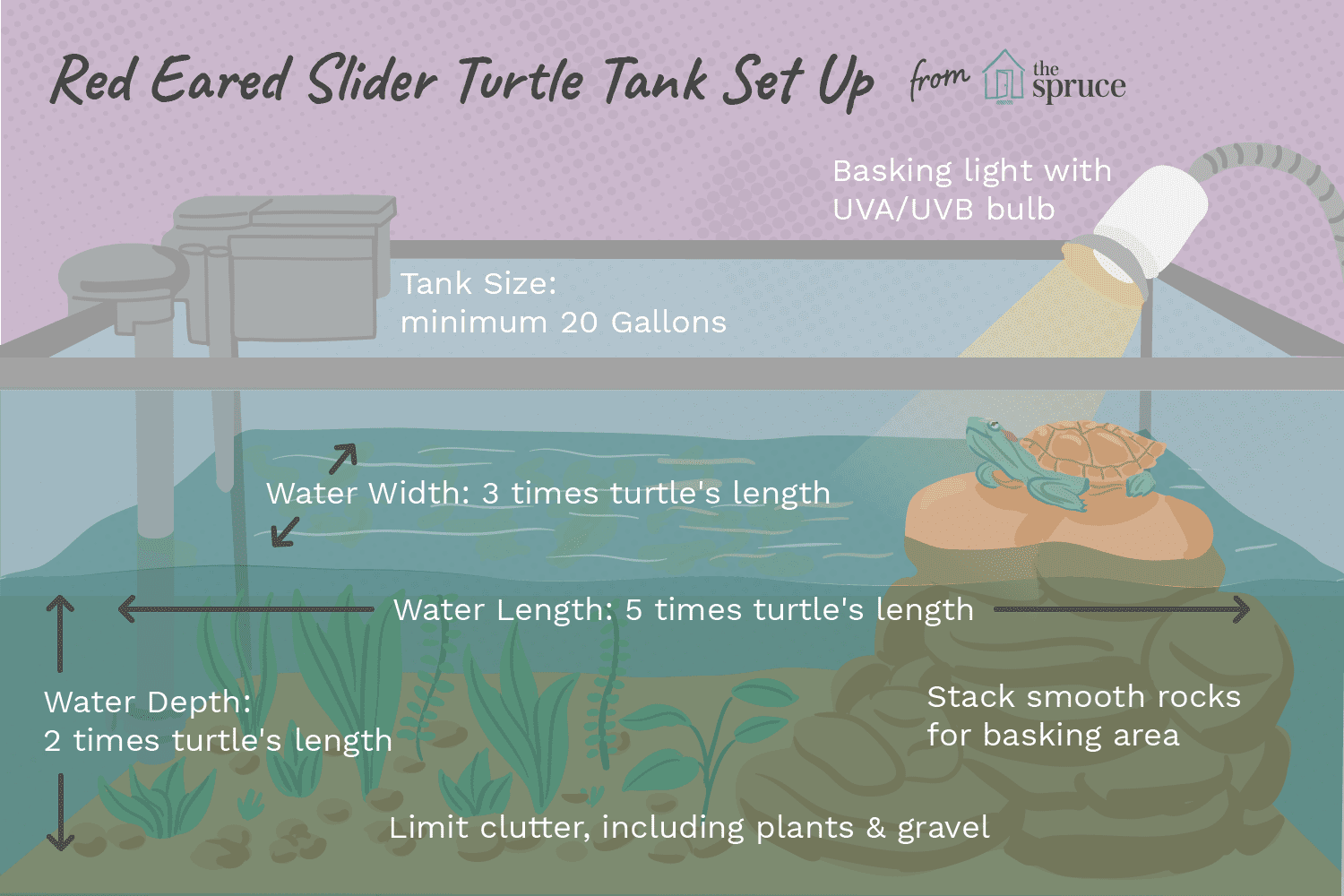So you’ve finally decided to bring a turtle into your home, but now comes the important task of setting up the perfect turtle tank. This article will guide you through the essential equipment you’ll need to create a comfortable and safe environment for your new pet. From the right tank size and filtration system to the proper heating and lighting setup, we’ll cover all the necessary components to ensure your turtle thrives in its new habitat. Additionally, we’ll provide you with some maintenance tips to keep your tank clean and your turtle healthy. So get ready to create the perfect turtle paradise!
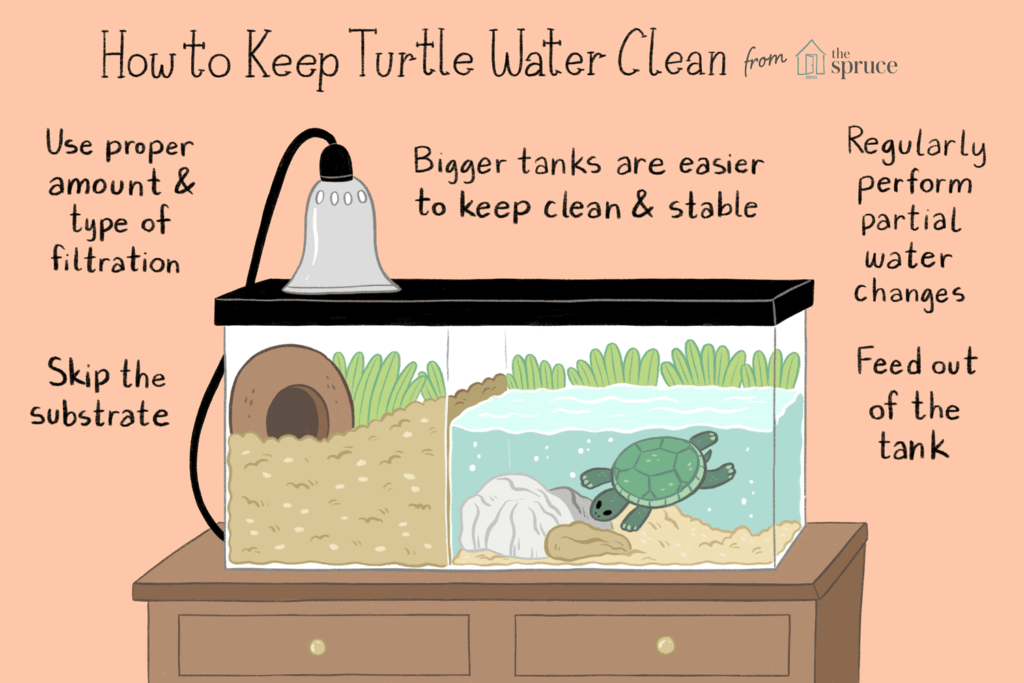
Tank Size
When it comes to setting up a turtle tank, determining the appropriate tank size is crucial. A proper tank size is essential for the overall health and well-being of your turtle. A tank that is too small can lead to stress, stunted growth, and behavior issues. On the other hand, a tank that is too large may cause difficulties for your turtle to find its food or basking spot.
When considering the tank size, you should take into account the size and species of your turtle. Different turtle species have varying space requirements. For example, larger turtles like the Red-Eared Slider will need a larger tank compared to smaller species like the Eastern Box Turtle. Researching the specific needs of your turtle species will help you determine the appropriate tank size.
Beyond the size of your turtle, it’s also essential to consider their activity level. Some turtles are more active swimmers, while others are more terrestrial. Turtles that require ample swimming space will need larger tanks compared to those that spend more time on land.
It’s important to remember that turtles can grow significantly throughout their lives. As a result, it’s advisable to invest in a tank that allows for future growth. A good rule of thumb is to provide at least 10 gallons of water per inch of the turtle’s shell length. However, bigger is usually better when it comes to tank size.
Filtration System
Maintaining clean and healthy water is vital for your turtle’s well-being. Turtles are messy creatures, and their tanks can quickly become dirty without an efficient filtration system. A reliable filtration system will remove waste, excess food, and harmful chemicals from the water, ensuring a safe environment for your turtle.
There are several types of filtration systems available for turtle tanks, each with its own pros and cons. The most commonly used types include mechanical, biological, and chemical filtration. Mechanical filtration removes debris from the water, while biological filtration breaks down harmful substances through beneficial bacteria. Chemical filtration uses activated carbon to eliminate impurities and odors.
When choosing a filtration system, it’s important to consider the size of your tank and the specific needs of your turtle. For larger tanks or tanks with multiple turtles, a powerful and efficient filtration system is necessary. Additionally, be sure to regularly maintain and clean the filter to ensure its optimal performance.
Heating and Lighting
Maintaining the appropriate temperature in your turtle tank is essential for your turtle’s overall health and well-being. Turtles are ectothermic, meaning they rely on external sources to regulate their body temperature. Providing the correct heating and lighting setup will enable your turtle to thermoregulate, ensuring they can properly digest food and maintain a healthy immune system.
Different types of heaters are available for turtle tanks, including submersible heaters, basking bulbs, and heat lamps. Submersible heaters are typically used to warm the water, while basking bulbs and heat lamps provide a heat source for the basking area. It’s important to choose the appropriate heater for your tank size and the temperature needs of your turtle species.
In addition to heating, proper lighting is crucial for your turtle’s well-being. Turtles require both UVA and UVB light for optimal health. UVA light promotes natural behaviors and activity, while UVB light is necessary for the synthesis of vitamin D3, which aids in calcium absorption. Using a combination of basking bulbs and UVB lamps will help create a suitable lighting environment for your turtle.
Remember to regularly monitor the temperature and lighting conditions in your turtle tank to ensure they remain within the appropriate range. Temperature and lighting requirements may vary depending on the turtle species, so it’s important to research the specific needs of your turtle.
Substrate
Choosing the best substrate for your turtle tank is crucial for creating a comfortable and natural habitat. The substrate serves several purposes, including providing a place for your turtle to dig, lay eggs (if applicable), and explore. It also helps to maintain water quality by trapping debris and excess food.
There are various options available for turtle tank substrates, including river rocks, sand, gravel, and aquatic plants. River rocks are a popular choice as they are easy to clean and provide a natural aesthetic. Sand can replicate the natural habitat of certain turtle species but requires regular cleaning to prevent compaction. Gravel can also be used but should have larger pieces to prevent accidental ingestion. Aquatic plants not only add visual appeal but also contribute to the tank’s overall water quality.
When selecting a substrate, consider the preferences and size of your turtle species. Some turtles may prefer a sandy substrate for digging and laying eggs, while others may prefer a more rocky or planted environment. It’s important to regularly clean and maintain the substrate to prevent the buildup of waste and bacteria.
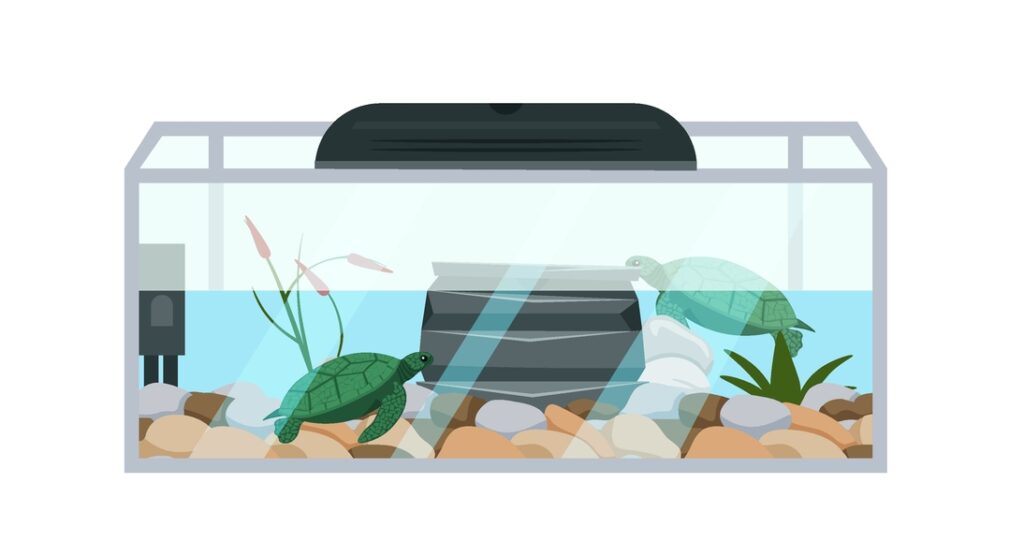
Basking Area
Providing a suitable basking area for your turtle is essential for their overall health and well-being. Turtles are ectothermic and rely on external heat sources to raise their body temperatures. A dedicated basking area allows your turtle to regulate its body temperature, dry out, and absorb UVB light.
When creating a basking area, you can use various materials such as rocks, logs, or commercial basking platforms. Rocks or logs can be arranged to create a sloping platform that mimics a natural environment. Commercial basking platforms are specifically designed for turtles and often come with adjustable ramps and non-slip surfaces.
Ensure that the basking area is large enough for your turtle to comfortably climb onto and bask. It should also be positioned near the heat source to provide the necessary temperature gradient. The basking area should be dry and accessible at all times to encourage regular basking behavior.
Decorations
Adding decorations to your turtle tank not only enhances its visual appeal but also creates a stimulating environment for your turtle. Turtles are curious creatures and providing them with hiding spots, climbing surfaces, and aquatic plants can prevent boredom and encourage natural behaviors.
There are various types of decorations you can incorporate into your turtle’s tank, including rocks, driftwood, PVC pipes, and artificial plants. Rocks and driftwood provide hiding places and climbing surfaces for your turtle. PVC pipes can be used to create tunnels, which turtles often enjoy exploring. Artificial plants can add visual interest and provide additional hiding spots.
When choosing decorations, prioritize the safety of your turtle. Avoid sharp or rough edges that could potentially injure your turtle. Ensure that any materials used are non-toxic and won’t leach harmful chemicals into the water. Regularly inspect and clean the decorations to maintain a clean and safe environment for your turtle.
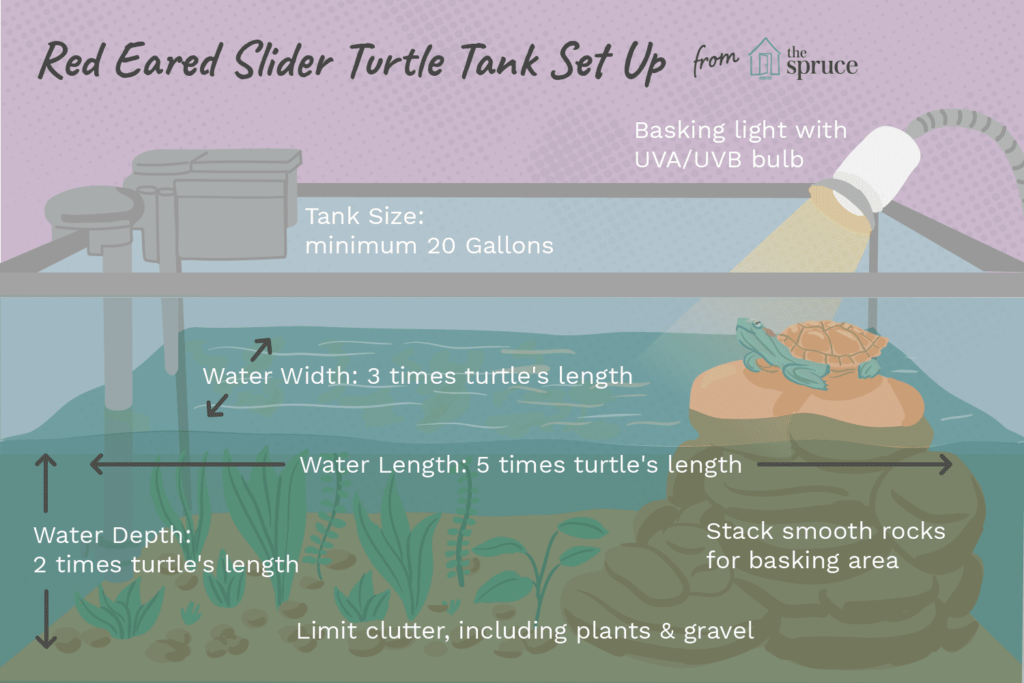
Water Quality
Maintaining clean and healthy water is crucial for your turtle’s well-being. Turtles are known for their messy habits, so it’s important to regularly test and monitor the water quality in their tank. Poor water quality can lead to various health issues and stress for your turtle.
Regular water testing is vital to ensure that the water parameters are within the appropriate ranges. Test kits are available to measure parameters such as ammonia, nitrites, nitrates, pH levels, and water hardness. Monitoring these parameters allows you to take timely corrective measures if any issues arise.
Routine water changes are also necessary to maintain optimal water quality. Partial water changes of 25-50% should be done every few weeks, depending on the tank size and the number of turtles. It’s important to use dechlorinated water and thoroughly clean the tank during water changes.
Additionally, using a siphon or turtle-friendly substrate cleaner can help remove debris, excess food, and waste from the tank bottom. Regularly cleaning your filtration system and replacing filter media as recommended will also contribute to better water quality for your turtle.
Feeding
Providing proper nutrition is key to maintaining a healthy and thriving turtle. Different turtle species have varying dietary requirements, so it’s important to research and understand the specific needs of your turtle. A well-balanced diet will ensure that your turtle receives the necessary vitamins, minerals, and nutrients for optimal growth and overall health.
Commercial turtle pellets or sticks are a good base diet for most turtle species. These pellets are usually formulated to meet the nutritional needs of turtles and are available in various sizes to accommodate different shell sizes. Additionally, you can supplement the diet with fresh or frozen foods such as shrimp, fish, earthworms, vegetables, and fruits.
Feeding frequency and portion control are also essential considerations. Most turtles should be fed daily when they are young and then transitioned to every other day or a few times a week as they mature. It’s important not to overfeed your turtle, as this can lead to obesity and health issues. Monitor your turtle’s weight and adjust the feeding schedule accordingly.
Remember to provide calcium and vitamin supplements as needed to ensure proper shell and bone development. Dusting the food with calcium powder or offering cuttlebone for calcium supplementation is recommended.
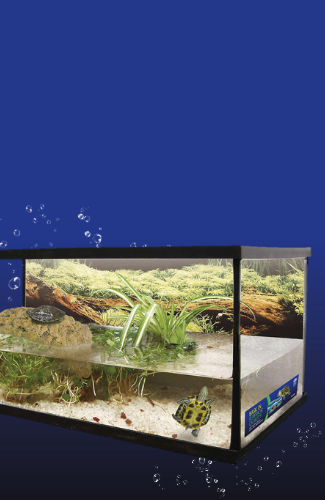
Handling and Interaction
Handling your turtle safely and appropriately is crucial for their well-being and for establishing a bond with your pet. While turtles may not enjoy being held or cuddled like other pets, they can still become accustomed to human presence and interaction.
When handling your turtle, it’s important to be gentle and calm. Supporting their body and avoiding excessive pressure on the shell is essential to prevent injury. Avoid handling your turtle excessively, as this can cause stress and discomfort. Short, supervised handling sessions will allow your turtle to become familiar with you without causing unnecessary anxiety.
Creating a stress-free environment for your turtle is also important for their overall well-being. Avoid sudden loud noises, excessive handling, or frequent rearrangement of decorations and furniture in the tank. Providing hiding spots and a tranquil environment will help your turtle feel safe and at ease.
While turtles may not exhibit affection like other pets, you can still bond with your turtle through interaction. Talking to your turtle and regularly spending time near their tank will allow them to become familiar with your presence. Offering treats or favorite food items during feeding time can also help establish a positive association with your presence.
Healthcare
Regular check-ups with a veterinarian are crucial for maintaining your turtle’s health and catching potential health issues early. Turtles are susceptible to various health problems, and timely veterinary care can make a significant difference in their well-being.
Common health issues in turtles include respiratory infections, shell infections, vitamin deficiencies, and parasites. Regularly observing your turtle for any signs of illness, such as loss of appetite, lethargy, changes in behavior, cloudy eyes, or abnormal growths, is important. If you notice any concerning symptoms, consult with a reptile veterinarian immediately.
Maintaining proper husbandry practices, such as providing a clean and appropriate environment, a balanced diet, and adequate heat and lighting, can significantly reduce the risk of health issues. Regularly clean and disinfect the tank and equipment, maintain proper water quality, and follow a strict hygiene routine.
In conclusion, setting up a suitable and comfortable habitat for your turtle is essential for their overall health and well-being. From tank size and filtration systems to heating, lighting, and substrate selection, each aspect plays a crucial role in creating a safe and stimulating environment. Regular cleaning, proper nutrition, and handling practices, along with regular veterinary check-ups, will help ensure that your turtle thrives and lives a happy and healthy life.
